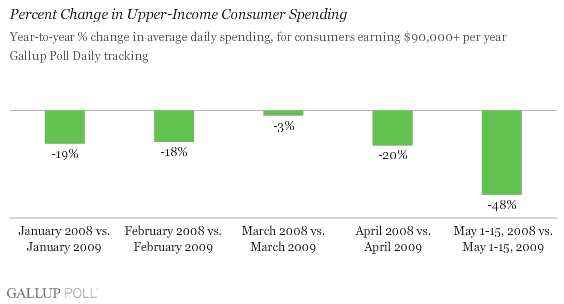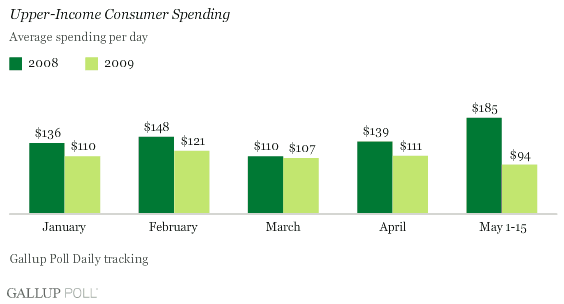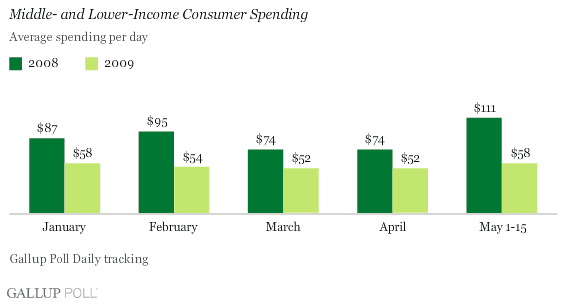PRINCETON, NJ -- Upper-income Americans' self-reported spending in stores, restaurants, gas stations, and online averaged $94 per day during the first 15 days of May -- down 15% from April and down 48% from the same period a year ago. Unless this turns around quickly, the economy is likely to see "dead shoots" replacing the "green shoots" of economic recovery -- particularly for upscale retailers and big-ticket-item sales.

Upper-Income Spending Worsening
Gallup's self-reported consumer spending measure finds that upper-income Americans (those earning $90,000 or more a year) spent 15% less during the first half of May (an average of $94 per day) than they did in April ($111) -- giving May the lowest average daily spending rate of the year. In terms of seasonally comparable spending, upper-income spending is off 48% from the first half of May 2008 -- also representing the sharpest year-to-year decline seen thus far in 2009. It should be noted that year-ago comparables are artificially high as a result of last year's relatively large tax rebates and their positive, if temporary, impact on consumer spending. Of course, this effect is mitigated somewhat in this instance because the rebates were phased out for many upper-income consumers.

Middle- and Lower-Income Spending
During the first half of May, Gallup's self-reported consumer spending measure among middle- and lower-income Americans showed a month-to-month increase of 12%, with average May spending increasing to $58 per day from $52 per day during April. However, when compared to a year ago, May 1-15 spending by these consumers is actually down 48%. This is worse than the 30% decline in year-to-year spending that has taken place in each of the past two months among middle- and lower-income consumers. This larger May decline could also reflect in part the impact of the 2008 tax rebates on May spending.

Commentary
Last week, the equities markets fell sharply for a day as April's retail sales disappointed. Gallup's Monitor of Consumer Spending for the first half of May suggests this is likely to be the case once again when May retail sales are reported, particularly with respect to year-ago comparables. In fact, upper-income consumer spending is not only declining this month, but doing so at an increasing rate compared to this time last year.
Of course, consumer spending comparables for last year at this time benefited from significant tax rebates -- even if they were short-lived and lacking in terms of multiplier effects, that is, they did not appear to generate new stimulative spending on top of the actual rebates themselves. This year's stimulus plan is likely to have a much more modest impact on consumer spending, given that the reduction in withholding rates is relatively modest compared to last year's tax rebates. Further, the $14.2 billion in one-time $250 checks -- also modest in comparison to last year's tax rebates -- for those receiving Social Security and supplemental security income payments, and for veterans getting disability and pensions, have only recently begun to arrive in recipients' mailboxes.
Stimulus discussions aside, it seems clear that upper-income Americans are continuing to pull back on their spending in May. In part, this may be the result of the sharp decline in their wealth in terms of both their home equity and their investments, not to mention the virtual nonreturns available on principal-guaranteed investments like bank CDs. In addition, the level of economic uncertainty remains extremely high, particularly with the way new proposals seem to be surfacing on a daily basis in the nation's capital. Finally, saving now seems more fashionable than spending.
Still, upper-income Americans -- even those already retired or approaching retirement -- are not likely to get much sympathy from the average American or their representatives in Washington, D.C. They are seen as benefiting disproportionately from the booming times of recent years and therefore needing to bear a disproportionate share of the losses and cleanup costs of the current economic debacle.Politics aside, however, upper-income Americans spend a disproportionate share of the nation's disposable income. If they continue to pull back on their spending, it is hard to see how the so-called "green shoots" of economic recovery can become anything other than "dead shoots." Downscale retailers may continue to benefit from the "trade-down effect," but upscale retailers, small businesses, and many others who provide discretionary products and services to the economy are likely to see a continued deterioration in their operating environments.
In order for all Americans to feel comfortable with spending more, they need to become more secure with their personal balance sheets, more certain about their job security, and less fearful that all of the changes currently being proposed will have a negative effect on them personally and/or on the companies where they work. In the meantime, current consumer spending levels may be the "new normal." Over the weeks and months ahead, Gallup Poll Daily tracking will reflect whether that is indeed the case.
Survey Methods
Gallup's Monitor of Consumer Spending is based on aggregated interviews with a nationally representative random sample of approximately 500 adults aged 18 or older each day. For monthly results that are based on samples of approximately 14,000, the maximum margin of sampling error is ±1 percentage points. Results for May 1-15, 2008, are based on a sample of 5,788 national adults and for May 1-15, 2009, on a sample of 5,490 national adults. For these samples, the maximum margin of sampling error is ±2 percentage points.
Interviews are conducted with respondents on land-line telephones (for respondents with a land-line telephone) and cellular phones (for respondents who are cell-phone only).
In addition to sampling error, question wording and practical difficulties in conducting surveys can introduce error or bias into the findings of public opinion polls.
